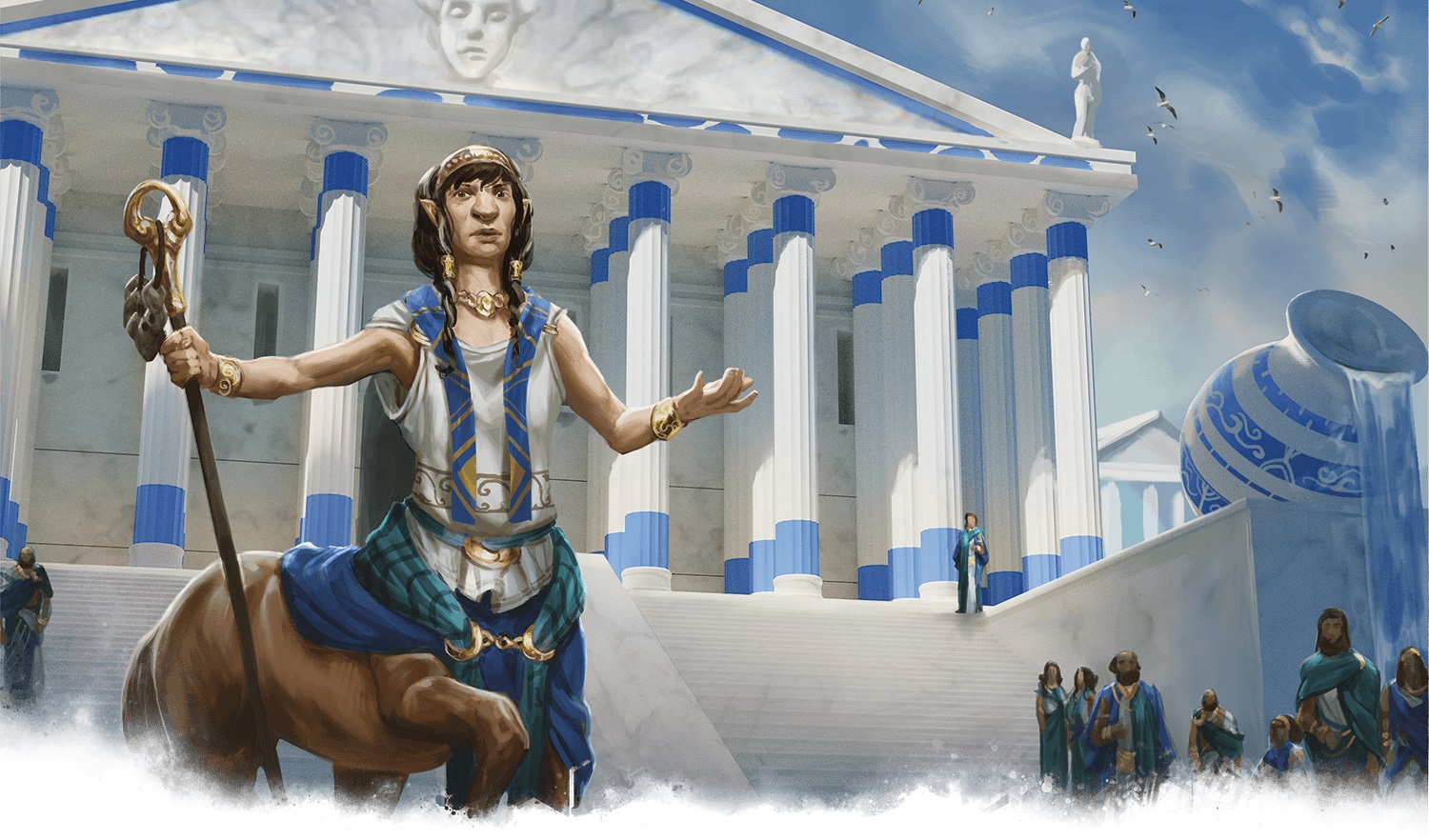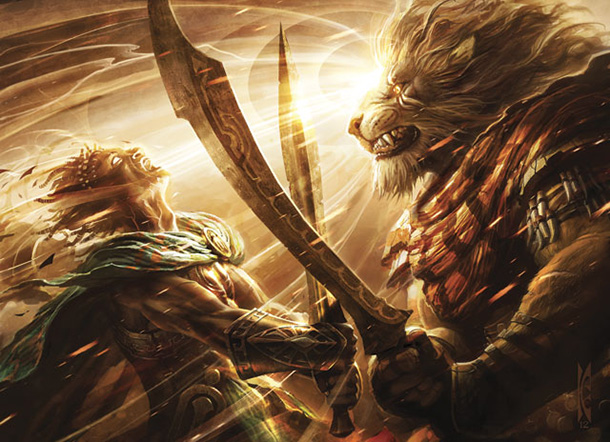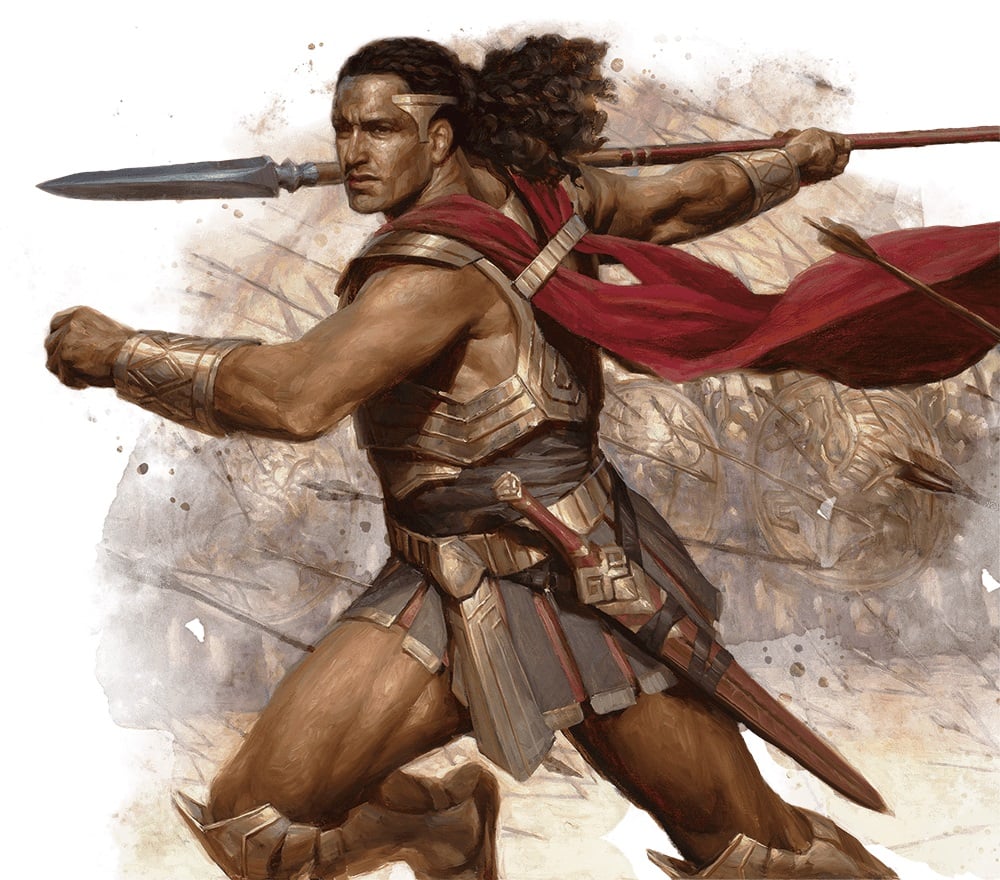D&D: Mythic Odysseys of Theros’ One Achilles Heel

Mythic Odysseys of Theros hits the spot just about every single time. Even when they miss the mark.
When it comes to splatbooks, Mythic Odysseys of Theros really knocks it out of the park. There’s a lot to love about it, from the new (and alliterative) mythic monster mechanics, to rules for creating adventures well outside the norm, to its love of high-powered action that sees heroes wielding the weapons of the gods (and levelling them up as they do so). But it’s not all fun and Panhellenic Games though. While there is a lot to love, there’s one place where they miss the mark. Yup, it turns out there’s just one key weakness that mars an otherwise impervious book. And it comes in the Player Options. Let’s take a look at what works, and what doesn’t, of the new player options in Mythic Odysseys of Theros.
First the good. The new races are awesome. Hedonistic Satyrs and Leonin are a blast to play with. They feel distinct from the other races that WotC has put out, and between Centaurs, Minotaurs, Elves, Dwarves, Dragonborn, Halflings, Gnomes, Yuan-Ti, Goblins, Kobolds, Gith, Tabaxi, Loxodon, Viashino, Simic Hybrids, and more, the fact that they remain so distinct is incredible. But even more noteworthy is the new Athlete background, which lets you be a famous sports-er.
You strive to perfect yourself physically and in execution of everything you do. The thrill of competition lights fire in your blood, and the roar of the crowd drives you forward. Tales of your exploits precede you and might open doors or loosen tongues.
Whether in one of the poleis, between them, or among the nonhuman peoples of Theros, physical contests and those who pursue them command respect bordering on reverence. Athletes arise from all walks of life and all cultures and quite often cross paths with one another.
It really fits with the theme of Theros. Games of physical competition abound in ancient Greece, and so do they in Theros. Pick an event like Hoplite Racing or a Marathon and that’s what your character is known for. There are some great personality traits that accompany this background, but the real shining star is its featured ability, which means that as long as you’re within 100 miles of where you have competed, you are 50% likely to meet someone who admires you. That’s right every other person you meet is willing to help or lend temporary shelter, because you’re so cool. It’s the feature bards wish they had. Pick it if you’re a fighter and make your bard green with envy.
Speaking of Bards, the College of Eloquence is here, with some updates from its previous incarnation in Unearthed Arcana, trading in some of their abilities like Soothing Words, which used to allow you to cast calm emotions a number of times equal to your Charisma modifier for free, for Silver Tongue, which lets you treat a persuasion check of 9 or less as though you’d rolled a 10. Unsettling Words and Universal Speech have been swapped, meaning that you don’t get access to Tongues faster than any other class, but instead you do gain the ability to use your Bardic Inspiration die to penalize enemy saving throws at 3rd level.
But in the Oath of Glory, formerly the Oath of Heroism, we hit the big falter. The two subclasses are different… and while the revised version has some improvements, it cuts out some of the unique flavor of the subclass. The revised spell list is pretty on-brand. You get Guiding Bolt and Heroism, Enhance Ability and Magic Weapon, Haste and Protection from Eneergy, Compulsion and Freedom of Movement, and Commune and Flame Strike. All of which feel like big glorious hero kind of spells.
And the initial changes to Channel Divinity seem pretty cool. Peerless Athlete remains as it was in the UA. You can give yourself advantage on Strength and Dex checks for ten minutes, as well as double the normal amount of weight you can carry and increase your long and high jumps by ten feet.
Legendary Strike, which once let you score a crit on a 19 or 20, has been replaced with Inspiring Smite, and I think that works better. You can use Channel Divinity when you smite a foe, and distribute extra temporary hit points equal to 2d8 + your level among chosen creatures within 30 feet of you (including yourself). But the lack of crit bonus ties into the 7th level feature, which was once Mighty Deed and was awesome, letting you pick from gaining temporary hit points or making a creature Frightened of you for a turn.
Now it’s an Aura of Alacrity which is both your 7th and 18th level feature and it’s markedly less exciting. It’s an Aura with only a 5 foot range, and if your party members start their turn inside it they get 10 extra feet of movement that turn. It’s situationally useful at best, and is easily the weakest of Paladin Auras. Eventually it becomes 10 feet.
But in these changes the Oath of Glory loses a lot of its Heroism. Still, the book delivers the goods ultimately, and even though the Oath of Glory is a weaker option than you might like, there’s still a ton for players to dig into with this new book.
Happy Adventuring!







